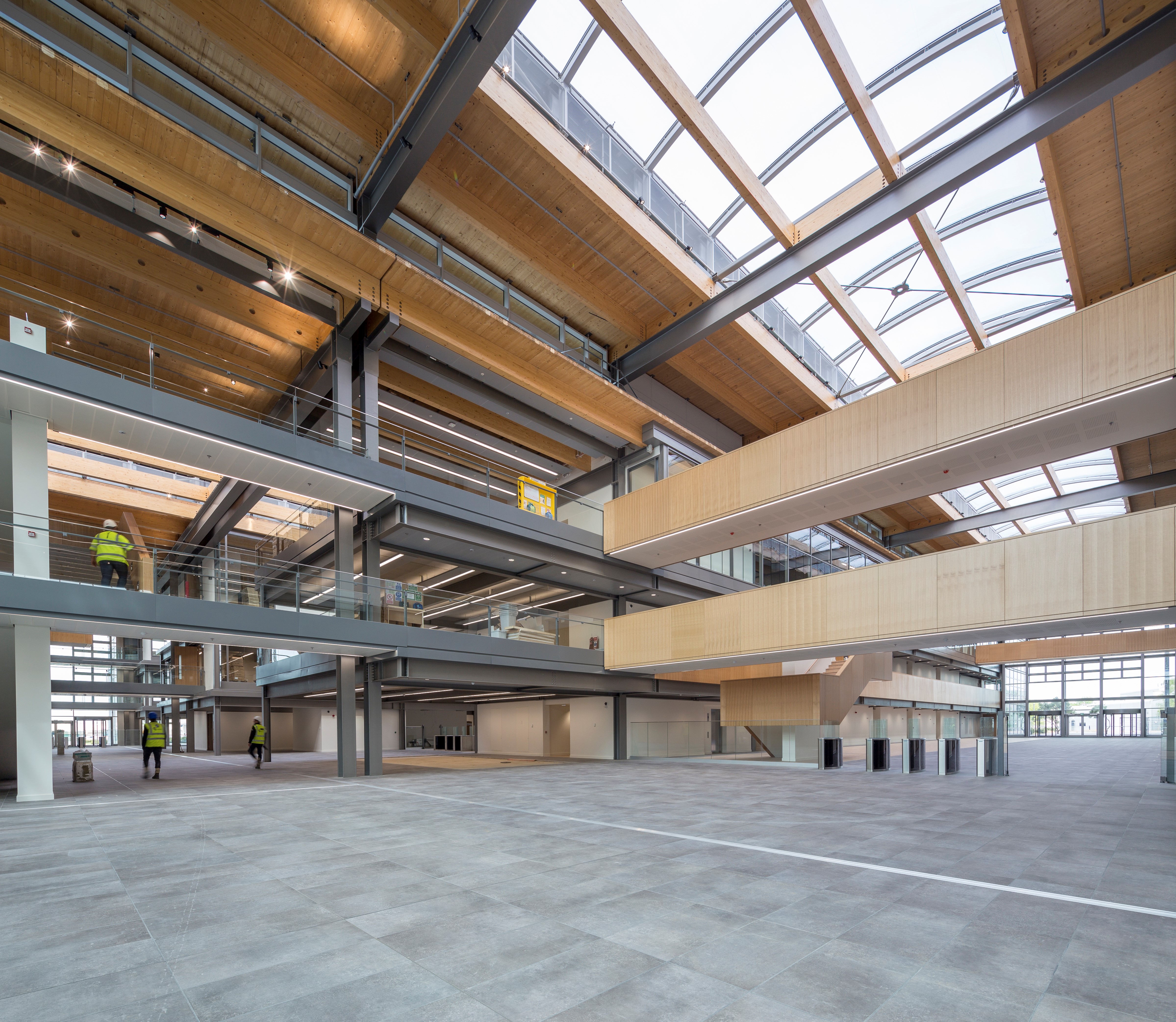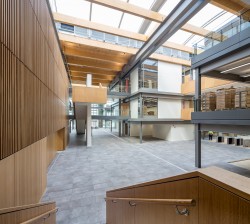Winner of two Structural Timber Awards, the £200million expansion represents the first major construction project at one of the company's nonmanufacturing sites in more than a decade. The development is fitting for a company with ambitious plans for continued global growth. The new facility will deliver transformational change in the company's practices and working environment to help attract and retain the best staff. 3,500 designers, engineers, purchasing and support staff occupy the new building, which will take the overall site population up to 11,500 – the size of a small town. This development is integral to JLR's wider expansion programme at the Banbury Road site in Warwickshire.
The engineered timber roof was delivered through a design for manufacture and assembly (DfMA) processes. Such a methodology has an affinity with one of the core activities at the heart of JLR. The design and connection detailing were optimised and tested in a virtual and pre-production environment before reaching the full manufacturing process – reducing costly reworks and errors onsite. Crucial to the lean and advanced manufacturing processes involved, was DfMA and BIM. The discipline and collaborative working that these progressive approaches facilitated met the needs of early design detail co-ordination and three-dimensional design information.

BIM played a critical role in the build, as most of the processes took place offsite. Panel geometry and specifications were detailed exactly through 3D modelling files which passed through the teams involved in the specification, design, and detailing stages. Manufacturing and machining of the panels were factory produced to 100% accuracy, facilitating a perfect fit, minimising transport costs and onsite waste. BIM ensured project timescales were optimised, problems relating to non-compliance and dimensional inaccuracies or clashes were kept to an absolute minimum, for fast and reliable erection. The output of the BIM design process, the IFC model was directly imported into the fabrication software eliminating the time-consuming translation of engineering information into cutting lists and assembly drawings.
The hybrid industrial visual grade CLT and glulam structure was designed to deliver permanent quality and long-term energy efficiency, requiring little or no maintenance, to meet the sustainability objectives. The new facility will deliver transformational change in the company's practices and working environment to help attract and retain the best staff. Exposed timber creates a natural, inviting and calming environment with enhanced acoustic properties which dampens sound, generating pleasant and peaceful workspaces.
The solid wood structure was able to meet the natural look and feel that JLR required together with the low thermal resistance and airtightness that the structure demanded to meet the challenging design brief. Stringent detailing and accuracy were critical when designing the timber elements and connection detailing. B&K Structures therefore used 3D modelling to ensure that there was no loss of performance in the final product. With a well established sustainable supply chain, the correct manufacturing partners were appointed and aligned with the requirements for sustainably sourced materials that were PEFC-certified. The synergy throughout the timber supply chain enabled the partners to define structural, physical and mechanical properties, so that the designed building physics could be easily implemented and tested. The building was designed to deliver permanent quality and long-term energy efficiency, to meet the sustainability objectives.
The roof's fabric is finely tuned to optimise performance. Adopting a hybrid approach, the structure is designed to be as lean and efficient as possible. Maximising performance in this way has resulted in a roof with the lowest possible amount of embodied carbon. Largely, this was achieved by maximising the U-values and airtightness in order to reduce the energy required across the lifespan of the building. Maximising offsite manufacturing methods, the project was delivered in a shorter programme than could be achieved using more traditional building methods. The use of timber proved a unique, innovative solution in comparison to other building materials and alternative methods of construction.
Onsite construction would have also generated higher levels of waste, dust and noise. The timber roof will only need minimal maintenance during the building's lifetime as the solid timber sections prevent dust getting trapped as it would with steel sections. The timber structure is designed for 90 minutes of fire resistance, protection of the galvanised steel connections was achieved by recessing within the body of the glulam and CLT. As most of the operations were offsite, the project achieved a RIDDOR free installation. The project represented the largest CLT roof deck constructed by B&K Structures, the design of the steel to glulam connections being a primary factor in the accuracy of the frame, speed of construction and the ability to safely install – the roof was constructed over an eight month period with no reported H&S incidents.
CLT delivered maximum programme benefits, reduced capital and lifecycle costs, whilst minimising the impact on the environment. Engineered timber is now being used as a positive means of enhancing working environments and strong evidence is now emerging on the impact timber can have on the comfort and wellbeing of occupants. Chris Elliott, Programme Director for Jaguar Land Rover, said: "The new design and engineering centre is a testament both to JLR's British heritage of innovation and its compelling vision for future technology. The new space will centralise our design, product engineering and purchasing functions in an original and modern environment, as well as creating additional capacity for the future."
For more information visit: www.bkstructures.co.uk









